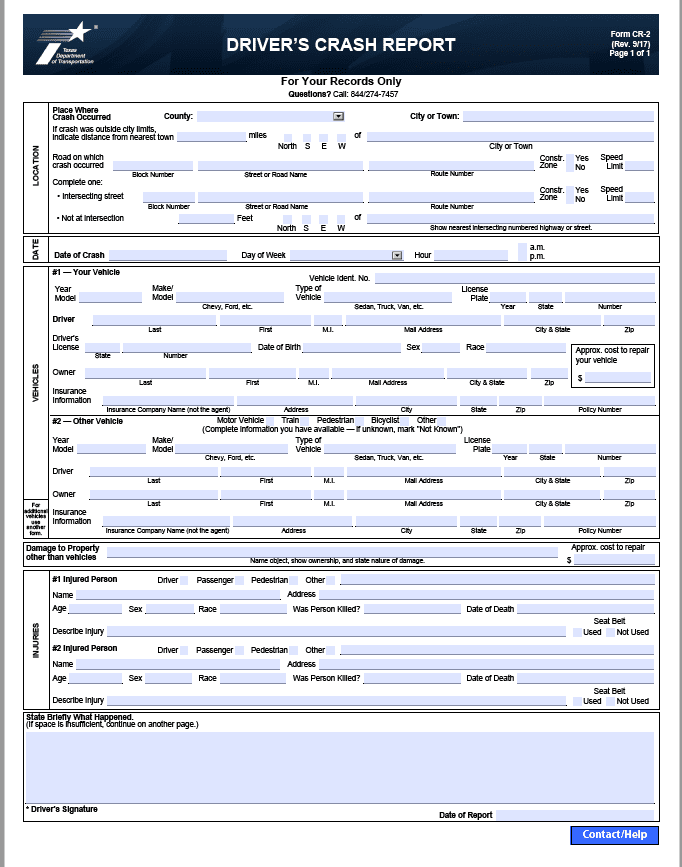What is a Driver’s Crash Report – Form CR-2 – Texas Blue Form?
Normally, after an accident, the parties involved call “911” or the police and report the accident. If the police respond to a motor vehicle accident they then should complete a Texas Peace Officer’s Crash Report (CR-3). However, if for some reason the police do not show up or do not complete an official Texas Peace Officer’s Crash Report, the Texas Driver’s Crash Report – Form CR-2, is designed to allow the drivers involved in a crash to provide their explanations of the details of the accident to the Texas Department of Transportation.
It is not advisable for a party involved in an accident to complete a CR-2 unless you absolutely must and only with the assistance of your attorney. Completing this form incorrectly could hurt your case and hender your chances of getting an equitable settlement.
Why Would There Be No Police Report?
In the perfect world, police officers would immediately show up after a crash, appropriately document it, collect all relevant evidence, conduct a full and thorough investigation and after considering all of the evidence make reasonable and prudent determinations as to causation. However, in the real world, police officers have other obligations and sometimes they simply cannot timely respond to a “minor” crash scene at all.
As a practical matter, if after an accident you or loved one calls “911” to report the accident but tell them that no is hurt, that significantly increases the chances that the police may not respond to the accident scene. However, police will almost always more readily respond to an accident if there are injuries reported during the “911” call. If you do not know if anyone was injured as a result of the accident, when reporting that accident to “911” or the police, it is suggested that you to tell them that you do not know but that it is possible, and to request immediate emergency assistance. If people are injured, please report that immediately, and the police should respond accordingly. Once an investigating officer responds to the scene of the accident, demand that a Texas Peace Officer’s Crash Report (CR-3) be completed and request the investigating officer’s business card.
What is the Driver’s Crash Report – Form CR-2 – Blue Form Used For?
The Texas Driver’s Crash Report – Form CR-2 – Blue Form, is designed to allow drivers to provide their explanations of the details of the accident to the Texas Department of Transportation “DOT”) when there is no Texas Peace Officer’s Crash Report. This serves as documentation of your crash for various TxDOT statistics; however, it could potentially be used in your case either for or against you.
It should be noted that a Driver’s Crash Report – Form CR-2 does not hold the same weight or authority in court as a Texas Peace Officer’s Crash Report. A police report is often seen as being more objective and more reliable as it is completed by a neutral party (the investigating officer) and who is specially trained and experienced in investigating motor vehicle accidents. A Driver’s Crash Report – Form CR-2 – Blue Form, on the other hand, is viewed as being less objective and less reliable as it is a report generated by one of the parties involved in the wreck who has a direct interest in the case and has no education or training in accident investigation, and as such, carries less weight.
When Am I Required To Fill Out A Blue Form?
Under the below circumstances, Texas law requires drivers involved in a motor vehicle accident fill out a Texas Driver’s Crash Report – Form CR-2 – Blue Form:
- An injury or death occurred as a result of the accident, you must fill out a Blue Form,
- Or, if there appears to be property damage at an estimated value of $1,000 or more to either party’s property, you must fill out a Blue Form.
Remember, though, the whole idea behind a Texas Driver’s Crash Report – Form CR-2 – Blue Form is that an officer either was not available to create a report or he declined to do so; therefore, you are not required to fill out a Blue Form if an officer created a report for your accident.
Again, it cannot be stressed enough that if you are required to fill out a Texas Driver’s Crash Report – Form CR-2 – Blue Form, your form should be reviewed by an attorney before submission.
How Long Do I Have to File a Blue Form?
Like police officers who submit Texas Peace Officer’s Crash Reports – CR-3 reports, you need to file your Driver’s Crash Report – Form CR-2 within 10 days of the accident. Please take note that there may be penalties for failing to submit a blue form within the deadline.
Where Can I Find a Texas Blue Form and How Do I Fill it Out?
A Texas Driver’s Crash Report – Form CR-2 – Blue Form can be filled online through the TxDOT website or at https://www.txdot.gov/government/enforcement/crash-records.html. Please note that there are different blue forms for various years, so please make certain you fill out the version from the year of your crash. An example of the current version for recent crashes that occurred on or after Sept. 1, 2017, is below:
As a practical matter, when filling out your Texas Driver’s Crash Report – Form CR-2 – Blue Form keep it simple and just stick to the crash facts. Even if the accident was the result of another driver’s negligence, the Blue Form is not the place to rant about causation and/or to provide your opinions as to liability. It should simply be the facts of what happened. It is a lot more helpful for you to explain the accident as a simple, factual chain of events. Although the blue form is a chance for you to tell your side of the story, you want to provide as much of an unbiased perspective as possible.
Again, your best bet is to get a free consultation from our attorneys before you fill out a Texas Driver’s Crash Report – Form CR-2 – Blue Form.
What Information is Included on the Texas Driver’s Crash Report – Form CR-2 – Blue Form?
As you can see from above, the information requested on a Texas Driver’s Crash Report – Form CR-2 – Blue Form includes the following:
- Location of the Crash
- Date of the Crash (including the time if known)
- Identification of the vehicles involved in the Crash (your vehicle would be listed first)
- Identification of the owners the vehicles involved in the Crash
- Insurance information for the vehicles involved in the Crash
- Approximate cost of repair to your vehicle
- Identification of injured parties and their injuries sustained in the Crash
- A narrative of what happened, in a driver’s statement
- Your signature attesting that the information on the form is correct
Blue Forms are Not Very Helpful but They Could Hurt Your Case
In most cases, all of the parties to a crash will submit a Texas Driver’s Crash Report – Form CR-2 – Blue Form, at which point they are merely witness statements from interested parties. As such, a Texas Driver’s Crash Report – Form CR-2 – Blue Form is simply each driver’s statement versus the opposing party’s statement. In these kinds of cases, Blue Forms may not be very helpful.
As a practical note, the only time that Blue Forms are put to use is when opposing parties, their attorneys, and/or their insurance companies attempt to use them against you. The person who caused the wreck or their attorneys (or insurance companies) will be delighted to scrutinize your every statement in the report and attempt to find ways to use it against you. Providing accurate information is essential but providing any additional information could be problematic and could result in you not being properly compensated for your damages.
Contact Chandler | Ross, PLLC For A Free Case Review
Please if you or a loved one is involved in a motor vehicle crash – before you file a Texas Driver’s Crash Report – Form CR-2 – Blue Form that could jeopardize your case — contact our attorneys at Chandler | Ross, PLLC.
With offices in Denton, Dallas and Fort Worth, Texas, Chandler | Ross, PLLC and our Car Accident Attorneys are well positioned to provide the most effective, experienced and highly-skilled representation possible with a convenient location near you. Our experienced Denton/Dallas/Fort Worth Car Accident Attorneys can quickly respond to an accident, gather necessary information and preserve evidence in order to maximize your chances of recovery. Don’t wait, and don’t compromise – contact us today to see how we can help you. In most cases, you pay nothing unless we are able to settle your case or win a verdict. Our consultation is free. Contact us now at (940) 800-2500 or support@chandlerrosslaw.com to schedule your free car accident case evaluation and consultation.



